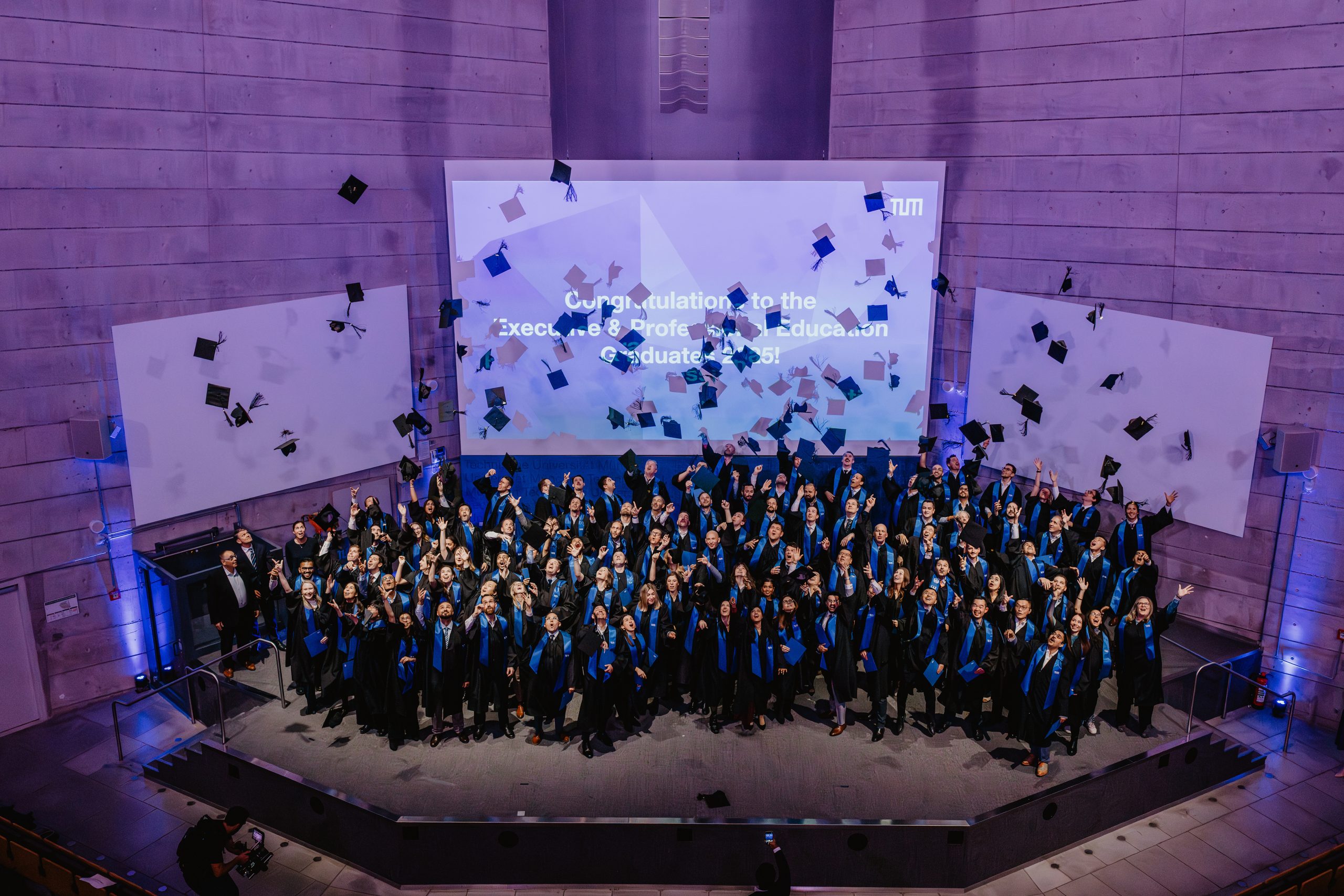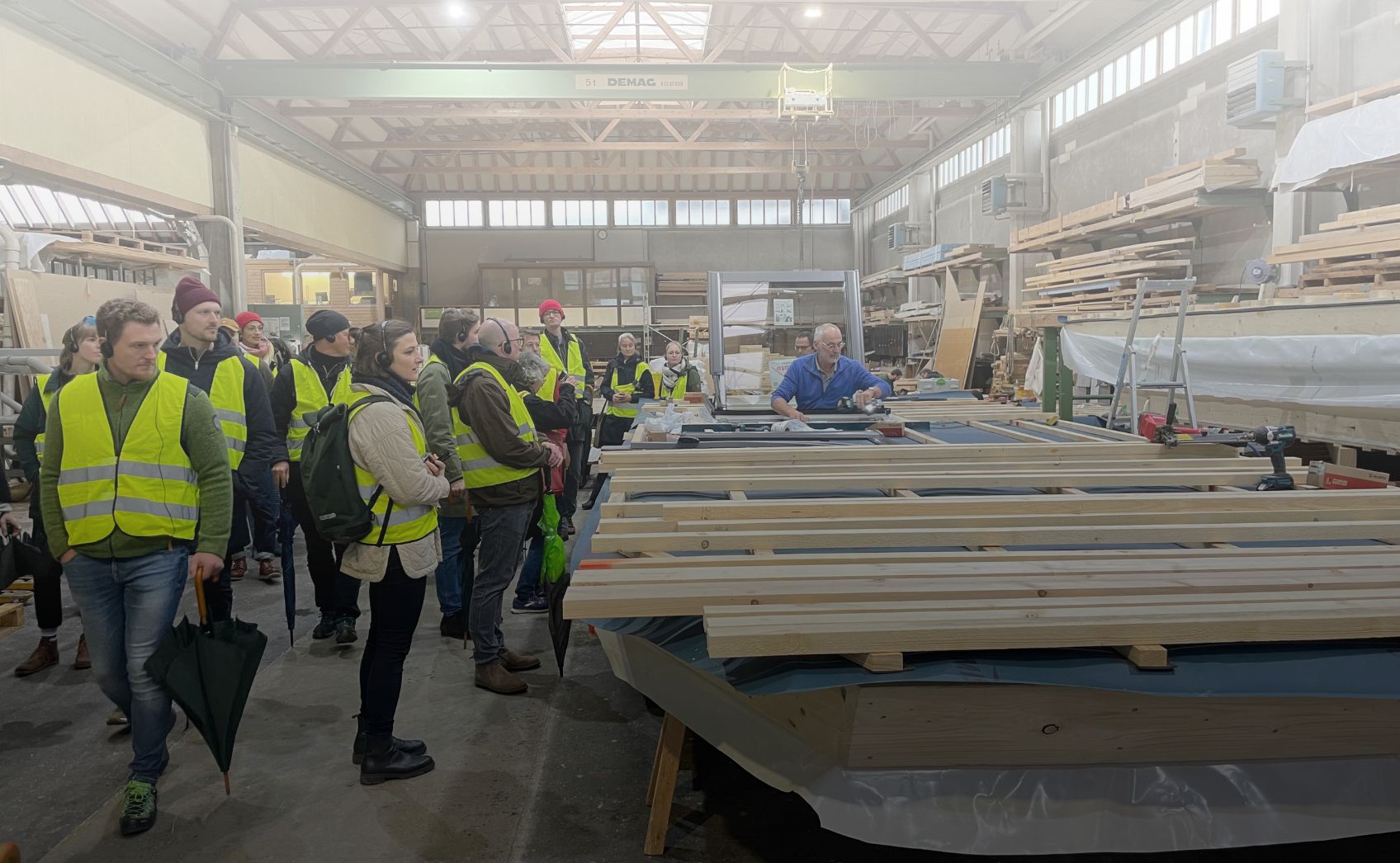Weiterbildung für Fach- und Führungskräfte
Die Technische Universität München (TUM) bietet Ihnen ideale Voraussetzungen für lebenslanges Lernen.
Zugeschnitten auf die Bedürfnisse von Berufstätigen reichen unsere Weiterbildungsprogramme von kurzen eintägigen Workshops über Zertifizierungen mit Industriestandard bis hin zu vollwertigen akademischen Masterabschlüssen der Technischen Universität München. Individuelle Formate für Führungskräfte, flexible Onlinekurse, sowie maßgeschneiderte Programme für Organisationen gehören ebenso zum Weiterbildungsangebot des TUM Institute for LifeLong Learning. Wachsen Sie mit uns!
Master & MBA
Unser Studienangebot für Fach- und Führungskräfte.
Zertifikatsprogramme
Vielfältige Weiterbildungsangebote für Berufstätige.
Für Organisationen
Maßgeschneiderte Angebote für Unternehmen und internationale Universitäten.
Finden Sie das richtige Programm für sich.
Mit unserem Program Finder erhalten Sie schnell und einfach einen Überblick über alle Programme und können nach Ihren Präferenzen auswählen.
Vier Gründe für das TUM Institute for LifeLong Learning
Nutzen Sie das Ökosystem der TUM, profitieren Sie von der unternehmerischen Denkweise der Universität und verbinden Sie neueste Erkenntnisse aus Forschung, technologischem Fortschritt und Praxis.
01
1
Vereinen Sie Forschung und Praxis.
Die TUM ist Vorreiterin in der Entwicklung neuer Technologien und führend in den Natur- und Sozialwissenschaften. Von Medizin über Management bis hin zu Leadership – die Forschungszentren der TUM decken die gesamte Bandbreite der Weiterbildungsdisziplinen ab. Wir schöpfen aus ihrem Wissen und übertragen Spitzenforschung auf die Bedürfnisse von Menschen und Organisationen aus der Praxis.
Die TUM ist Vorreiterin in der Entwicklung neuer Technologien und führend in den Natur- und Sozialwissenschaften. Von Medizin über Management bis hin zu Leadership – die Forschungszentren der TUM decken die gesamte Bandbreite der Weiterbildungsdisziplinen ab. Wir schöpfen aus ihrem Wissen und übertragen Spitzenforschung auf die Bedürfnisse von Menschen und Organisationen aus der Praxis.
02
2
Fördern Sie Verantwortungsbewusstsein.
Inhalte, Lehre und Design unserer Programme sind von einem werteorientierten Ansatz geprägt – und folgen unserer Überzeugung: Nur mit einer verantwortungsbewussten Denkweise lassen sich aktuelle und zukünftige Herausforderungen unserer Gesellschaft effektiv und nachhaltig bewältigen.
Inhalte, Lehre und Design unserer Programme sind von einem werteorientierten Ansatz geprägt – und folgen unserer Überzeugung: Nur mit einer verantwortungsbewussten Denkweise lassen sich aktuelle und zukünftige Herausforderungen unserer Gesellschaft effektiv und nachhaltig bewältigen.
03
3
Nutzen Sie die Potenziale technologiegestützten Lernens.
An der TUM entwickeln wir neue technologiegestützte Lehr- sowie Lernmethoden und integrieren diese in unsere Weiterbildungsprogramme. Dabei haben wir stets die Bedürfnisse unserer Teilnehmenden im Blick. Mit einem strukturierten und individualisierten Lernansatz, helfen wir ihnen dabei, ihr volles Potenzial auszuschöpfen.
An der TUM entwickeln wir neue technologiegestützte Lehr- sowie Lernmethoden und integrieren diese in unsere Weiterbildungsprogramme. Dabei haben wir stets die Bedürfnisse unserer Teilnehmenden im Blick. Mit einem strukturierten und individualisierten Lernansatz, helfen wir ihnen dabei, ihr volles Potenzial auszuschöpfen.
04
4
Profitieren Sie von einem exzellenten internationalen Netzwerk.
Die TUM verfügt über ein einzigartiges Netzwerk: Die Universität arbeitet mit führenden Forschungseinrichtungen, renommierten Unternehmen und zukunftsweisenden Start-ups zusammen. In unseren Weiterbildungsprogrammen fördern wir den interdisziplinären Austausch und vernetzten unsere Teilnehmenden und Alumni mit Partner aus Akademia und Wirtschaft.
Die TUM verfügt über ein einzigartiges Netzwerk: Die Universität arbeitet mit führenden Forschungseinrichtungen, renommierten Unternehmen und zukunftsweisenden Start-ups zusammen. In unseren Weiterbildungsprogrammen fördern wir den interdisziplinären Austausch und vernetzten unsere Teilnehmenden und Alumni mit Partner:innen aus Akademia und Wirtschaft.

Eine der besten Universitäten Deutschlands
Die Technische Universität München belegt regelmäßig Spitzenplätze unter deutschen und europäischen Universitäten in nationalen und internationalen Rankings wie dem Shanghai-Ranking, QS, THE und dem Global Employability Ranking.
Was unsere Alumni sagen

Info Sessions
News & Insights
Abonnieren Sie unseren Newsletter
Erhalten Sie unsere neuesten Nachrichten, Einblicke, Veranstaltungs- und Programmhinweise direkt in Ihren Posteingang. Unser Newsletter wird alle 6-8 Wochen in englischer Sprache verschickt. Sie können ihn jederzeit wieder abbestellen.
Wie können wir helfen?
Email:
Telefon:
Sie sehen gerade einen Platzhalterinhalt von Facebook. Um auf den eigentlichen Inhalt zuzugreifen, klicken Sie auf die Schaltfläche unten. Bitte beachten Sie, dass dabei Daten an Drittanbieter weitergegeben werden.
Mehr InformationenSie müssen den Inhalt von reCAPTCHA laden, um das Formular abzuschicken. Bitte beachten Sie, dass dabei Daten mit Drittanbietern ausgetauscht werden.
Mehr InformationenSie sehen gerade einen Platzhalterinhalt von reCAPTCHA. Um auf den eigentlichen Inhalt zuzugreifen, klicken Sie auf die Schaltfläche unten. Bitte beachten Sie, dass dabei Daten an Drittanbieter weitergegeben werden.
Mehr InformationenSie sehen gerade einen Platzhalterinhalt von Instagram. Um auf den eigentlichen Inhalt zuzugreifen, klicken Sie auf die Schaltfläche unten. Bitte beachten Sie, dass dabei Daten an Drittanbieter weitergegeben werden.
Mehr InformationenSie sehen gerade einen Platzhalterinhalt von Google Maps. Um auf den eigentlichen Inhalt zuzugreifen, klicken Sie auf die Schaltfläche unten. Bitte beachten Sie, dass dabei Daten an Drittanbieter weitergegeben werden.
Mehr InformationenSie sehen gerade einen Platzhalterinhalt von Mapbox. Um auf den eigentlichen Inhalt zuzugreifen, klicken Sie auf die Schaltfläche unten. Bitte beachten Sie, dass dabei Daten an Drittanbieter weitergegeben werden.
Mehr InformationenSie sehen gerade einen Platzhalterinhalt von OpenStreetMap. Um auf den eigentlichen Inhalt zuzugreifen, klicken Sie auf die Schaltfläche unten. Bitte beachten Sie, dass dabei Daten an Drittanbieter weitergegeben werden.
Mehr InformationenSie sehen gerade einen Platzhalterinhalt von X. Um auf den eigentlichen Inhalt zuzugreifen, klicken Sie auf die Schaltfläche unten. Bitte beachten Sie, dass dabei Daten an Drittanbieter weitergegeben werden.
Mehr Informationen


